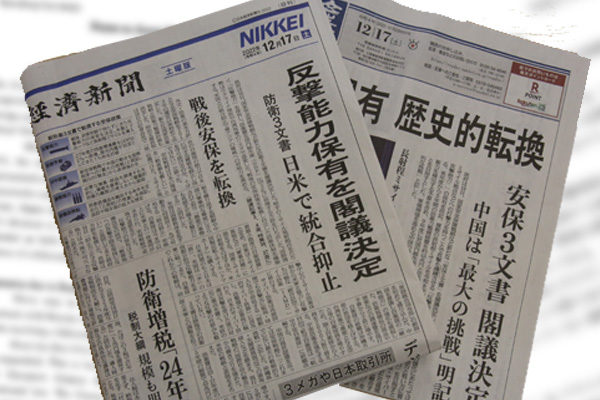At a cabinet meeting on December 16, the Japanese government decided on its three strategic documents, namely, the National Security Strategy, National Defense Strategy and Defense Buildup Program that feature Japan’s greatest postwar defense policy turnaround. I strongly appreciate these documents as demonstrating the government’s serious sense of crisis regarding China’s growing threat.
Enhancing capabilities to counter threats
Particularly, the plan to possess counterstrike capabilities represents a clear determination to firmly defend the country. The planned acquisition of both domestically developed long-range missiles and U.S.-made Tomahawk cruise missiles as a means of counterstrike capabilities demonstrates that Japan has to improve its deterrence as early as possible.
Under the Japan-U.S. alliance, Japan has been supposed to play a defensive role of a “shield” while the United States to take an offensive role of a “spear.” But Japan will assume some role of the spear by acquiring counterstrike capabilities.
Warning and surveillance to detect signs of enemy attacks, collecting information on specific targets, implementation of counterstrikes and an assessment after the strikes are indispensable for counterstrike capabilities to function.
The acquisition of domestically developed long-range missiles and Tomahawks alone does not create counterstrike capabilities. Japan and the U.S. need to discuss ways to work together including the revision of the Guidelines for Japan-U.S. Defense Cooperation.
The establishment of a permanent joint headquarters stipulated in the strategic documents is also significant. The failure of Russian invasion of Ukraine is partly attributable to the insufficient joint operations capabilities. When launching aggression against Ukraine, Russia did not have even a joint commander. In Japan, the necessity of a permanent joint headquarters has been pointed out since the 2011 Great East Japan Earthquake. However, any plan to create such a headquarters had failed to be materialized.
Prompt implementation of plans is a challenge
Furthermore, a stance that not only the Ministry of Defense but all other government agencies or the entire nation are responsible for national defense appears throughout the latest strategic documents.
The documents advocate the introduction of active cyber defense, the enhancement of outer space use, cross-governmental technological improvement and its proactive utilization, and the development and enhancement of public infrastructure in preparation for contingencies. This is based on the awareness that the Self-Defense Forces alone cannot achieve national defense. The documents also make clear that national functions must be comprehensively enhanced to protect Japanese citizens on remote islands or in enemy or conflict-ridden countries and secure energy and food supply in defending the lives and livelihood of the people.
Defense buildup in the coming five years is backed by 43 trillion yen in the planned defense spending, up some 50% from the past five years, and can be expected to have great deterrence effects. However, it is important for the defense buildup program to be implemented steadily and speedily. Concerned parties’ sincere efforts will be required along with the people’s understanding and cooperation.
Kiyofumi Iwata is a councilor at the Japan Institute for National Fundamentals. Formerly, he served as Chief of Staff of the Japan Ground Self-Defense Force.


